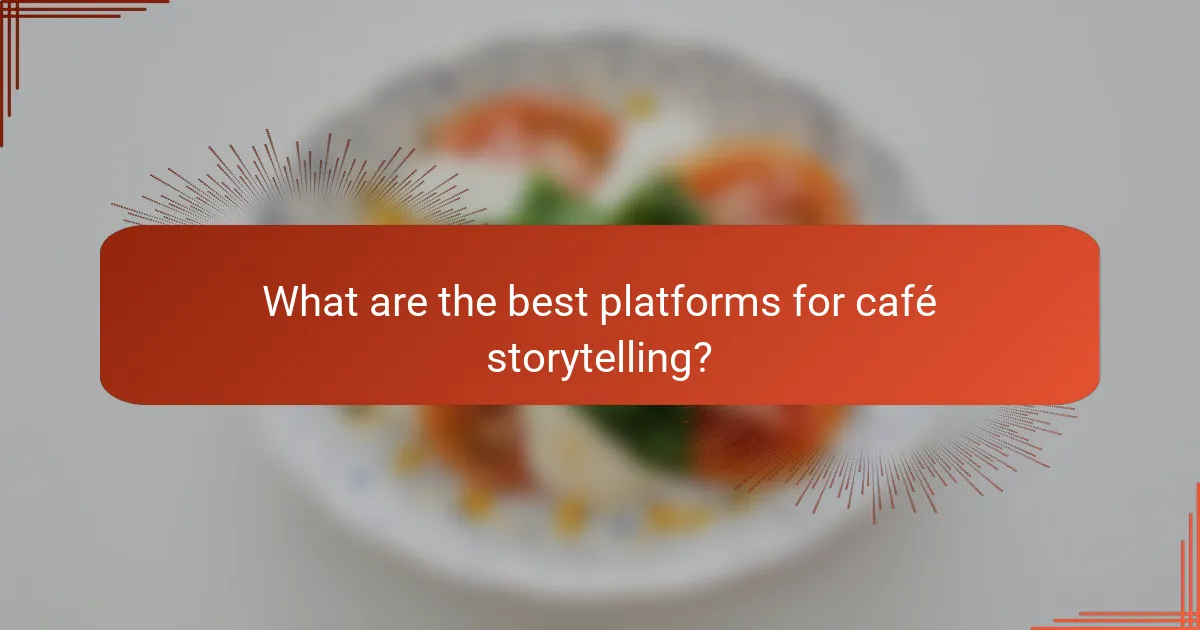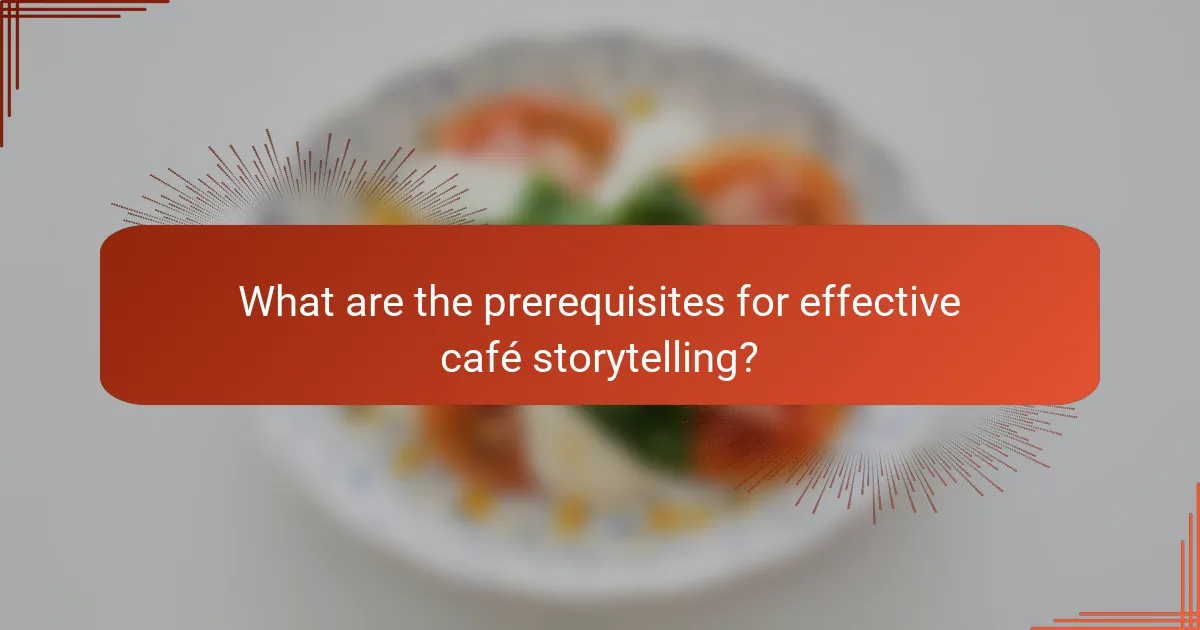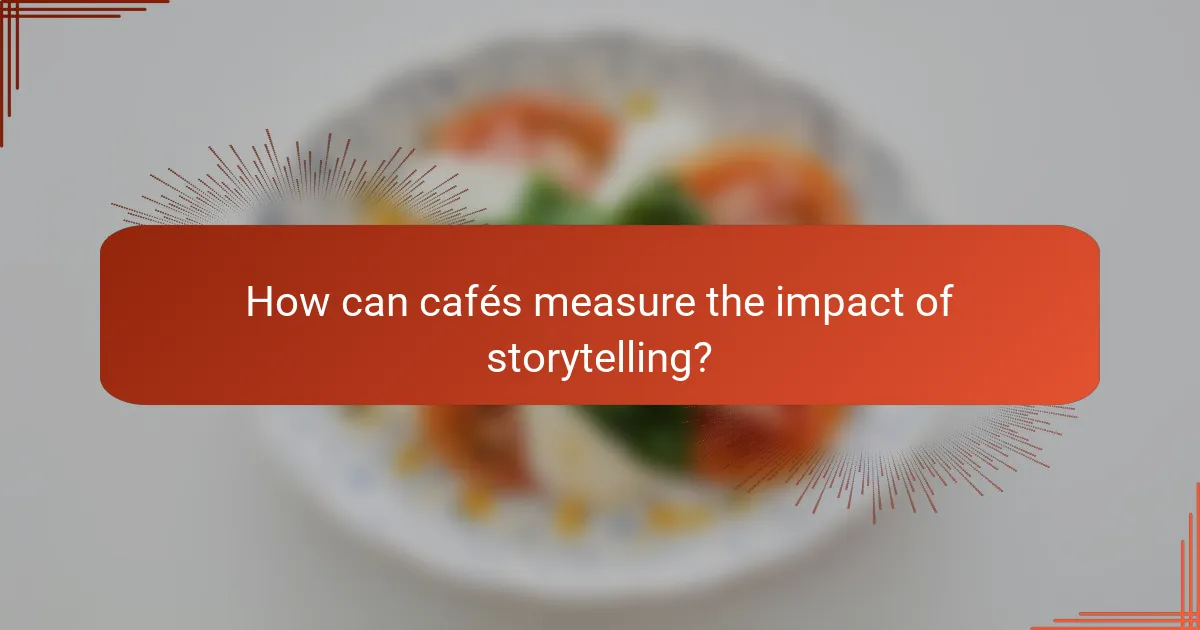Storytelling in café reviews transforms simple evaluations into immersive narratives that captivate readers. By incorporating personal anecdotes and rich descriptions, writers can evoke the ambiance of the café, allowing readers to feel a genuine connection to the experience. This engaging approach not only enhances the emotional impact of the review but also plays a vital role in influencing consumer decisions.

How can storytelling enhance café reviews?
Storytelling can significantly enhance café reviews by creating a narrative that resonates with readers, making the experience more relatable and engaging. By weaving personal anecdotes and vivid descriptions into reviews, writers can draw readers into the atmosphere of the café, making them feel as if they are part of the story.
Creates emotional connections
Storytelling fosters emotional connections by allowing reviewers to share personal experiences and feelings associated with their café visits. For instance, describing a memorable first date over coffee can evoke nostalgia and warmth, prompting readers to reflect on their own experiences. This emotional resonance can make the review more impactful and relatable.
Using sensory details, such as the aroma of freshly brewed coffee or the ambiance of the café, can further enhance these connections. When readers can visualize and feel the environment, they are more likely to remember the café and consider visiting it themselves.
Increases reader engagement
Engaging storytelling captures readers’ attention and encourages them to read through the entire review. A narrative that includes intriguing characters or unexpected events can pique curiosity and keep readers invested. For example, recounting a humorous interaction with a barista can make the review more entertaining and memorable.
To increase engagement, reviewers should aim for a conversational tone and include relatable scenarios. This approach invites readers to imagine themselves in the café, enhancing their desire to visit and experience it firsthand.
Improves memorability
Memorable café reviews often include unique stories or vivid imagery that stick in readers’ minds. By incorporating personal anecdotes or distinctive details about the café, such as its history or signature drinks, reviewers can create a lasting impression. For example, mentioning a café’s quirky decor or a special event can make it stand out among countless other options.
To improve memorability, reviewers should focus on crafting a strong opening hook and a compelling conclusion that ties back to the main story. This structure not only reinforces the narrative but also leaves readers with a clear takeaway that encourages them to remember the café long after reading the review.

What techniques are effective in café storytelling?
Effective café storytelling techniques engage readers by creating a vivid and relatable experience. Utilizing descriptive language, personal anecdotes, and vivid imagery can significantly enhance the emotional connection and overall impact of a café review.
Descriptive language
Descriptive language is essential in café storytelling as it paints a picture of the atmosphere, flavors, and overall experience. Use sensory details to evoke taste, smell, and sight, allowing readers to imagine themselves in the café. For example, instead of saying “the coffee was good,” describe it as “a rich, velvety espresso with notes of dark chocolate and a hint of caramel.”
Incorporate specific adjectives and adverbs to enhance your descriptions. Terms like “cozy,” “bustling,” or “artfully presented” can convey the café’s vibe and make the review more engaging. Avoid clichés and strive for originality to keep the reader’s attention.
Personal anecdotes
Personal anecdotes add authenticity and relatability to café reviews. Sharing a memorable experience, such as a first date or a quiet afternoon spent reading, allows readers to connect emotionally with the narrative. These stories can highlight unique aspects of the café, such as exceptional service or a special menu item.
When including anecdotes, focus on how the café made you feel and the memories associated with it. This personal touch can resonate with readers, making them more likely to visit the café themselves. Keep anecdotes concise and relevant to maintain the flow of the review.
Vivid imagery
Vivid imagery enhances storytelling by creating strong mental pictures that transport readers to the café. Use metaphors and similes to compare elements of the café experience to familiar concepts, making it easier for readers to visualize. For instance, describing the café’s ambiance as “a warm embrace on a chilly day” can evoke a strong emotional response.
Incorporate details about the café’s decor, lighting, and layout to enrich the imagery. Mentioning elements like “rustic wooden tables” or “soft, golden lighting” helps readers form a clearer picture. Aim for a balance between detail and brevity to keep the narrative engaging without overwhelming the reader.

How do café reviews impact consumer decisions?
Café reviews significantly influence consumer decisions by shaping perceptions and guiding choices. Positive or negative feedback can sway potential customers, making reviews a crucial factor in the café selection process.
Influences purchase behavior
Café reviews directly affect purchase behavior by providing insights into the quality of food, service, and atmosphere. When consumers read favorable reviews, they are more likely to visit that café, while negative reviews can deter them from making a purchase.
For example, a café with a high rating on platforms like Yelp or Google Reviews may see an increase in foot traffic, especially if the reviews highlight popular menu items or exceptional service. Conversely, a café with consistent negative feedback may struggle to attract new customers.
Builds trust and credibility
Reviews help build trust and credibility for cafés by offering social proof of their quality. When potential customers see numerous positive reviews, they are more inclined to believe that the café delivers on its promises.
Additionally, authentic reviews that include personal experiences can enhance a café’s reputation. For instance, a review detailing a memorable brunch experience can resonate with readers, making them more likely to choose that café over others. However, cafés should be cautious of fake reviews, as they can damage credibility and lead to consumer distrust.

What are the best platforms for café storytelling?
The best platforms for café storytelling include Instagram and blogs, each offering unique advantages for engaging audiences. Instagram excels in visual appeal, while blogs provide a space for detailed narratives and reviews.
Instagram for visual storytelling
Instagram is a powerful tool for visual storytelling, allowing café reviewers to showcase enticing images of food, drinks, and ambiance. High-quality photos can attract attention and evoke emotions, making followers feel connected to the café experience.
To maximize engagement, use relevant hashtags and geotags to reach a broader audience. Posting stories and reels can also enhance visibility, offering a dynamic way to share daily specials or behind-the-scenes glimpses.
Blogs for in-depth reviews
Blogs provide a platform for in-depth café reviews, allowing writers to explore the nuances of the café experience. This format is ideal for sharing detailed descriptions of menu items, service quality, and overall atmosphere, which can help readers make informed decisions.
When writing a café blog, consider including personal anecdotes or interviews with staff to add depth. Incorporating SEO strategies, such as keyword optimization and backlinks, can also improve visibility and attract more readers.

How can cafés leverage reader engagement?
Cafés can enhance reader engagement by creating interactive experiences that invite customers to share their stories and connect with the brand. This approach not only fosters a sense of community but also enriches the café’s narrative through diverse customer perspectives.
Encouraging user-generated content
Encouraging user-generated content (UGC) can significantly boost engagement. Cafés can invite customers to share their experiences on social media using specific hashtags, or by posting reviews on platforms like Google and Yelp. This not only provides authentic testimonials but also creates a sense of ownership among patrons.
To effectively gather UGC, consider hosting contests or offering incentives, such as discounts or free items, for the best stories or photos. This strategy can lead to a steady stream of content while enhancing customer loyalty.
Hosting storytelling events
Hosting storytelling events allows cafés to create immersive experiences that draw in customers. These events can include open mic nights, poetry readings, or themed storytelling sessions where patrons share their personal narratives. Such gatherings foster a community atmosphere and encourage repeat visits.
When organizing storytelling events, promote them through social media and local community boards. Collaborating with local authors or storytellers can also enhance the event’s appeal and attract a wider audience, making it a memorable experience for all involved.

What are the prerequisites for effective café storytelling?
Effective café storytelling requires a deep understanding of the target audience and a thorough knowledge of café culture. These elements help create engaging narratives that resonate with readers and enhance their connection to the café experience.
Understanding target audience
Identifying the target audience is crucial for effective storytelling in café reviews. Consider demographics such as age, lifestyle, and preferences, as these factors influence what resonates with readers. For instance, younger audiences may appreciate trendy cafés with unique offerings, while older patrons might prefer a cozy atmosphere with classic options.
Engage your audience by using language and themes that reflect their interests. For example, if writing for a health-conscious crowd, emphasize organic ingredients and sustainable practices. Tailoring your narrative to the audience’s values fosters a deeper connection and encourages them to explore the café.
Researching café culture
Understanding café culture involves exploring local trends, popular drinks, and the ambiance that defines different establishments. This knowledge allows you to highlight what makes a café unique and appealing. For example, in cities like Paris, cafés often emphasize a leisurely atmosphere, while in Melbourne, the focus may be on specialty coffee and vibrant social scenes.
To effectively convey café culture, immerse yourself in the local scene. Visit various cafés, interact with baristas, and observe customer behavior. This firsthand experience will enrich your storytelling, providing authentic insights that engage readers and enhance their understanding of the café’s place within the community.

What are the emerging trends in café storytelling?
Emerging trends in café storytelling focus on creating engaging narratives that resonate with customers. These trends leverage interactive formats and multimedia elements to enhance the overall experience and foster a deeper connection with the audience.
Interactive storytelling formats
Interactive storytelling formats allow customers to engage with the narrative actively. This can include social media polls, choose-your-own-adventure style posts, or live events where patrons can share their experiences in real-time. Such formats encourage participation and create a sense of community among café-goers.
To implement interactive storytelling, cafés can use platforms like Instagram Stories or Facebook Live to solicit feedback and stories from their customers. This not only enhances engagement but also provides valuable insights into customer preferences and experiences.
Integration of multimedia elements
Integrating multimedia elements, such as videos, images, and audio, enriches café storytelling by appealing to multiple senses. For instance, a café could share short video clips showcasing the preparation of signature drinks or highlight customer testimonials through visually appealing graphics. This approach can significantly enhance the emotional impact of the story being told.
When incorporating multimedia, ensure that the content is high-quality and relevant to the café’s brand. Use platforms like YouTube for video content and Pinterest for visually driven storytelling. Balancing multimedia with concise text can help maintain clarity while captivating the audience’s attention.

How can cafés measure the impact of storytelling?
Cafés can measure the impact of storytelling through customer feedback, sales data, and social media engagement. By analyzing these metrics, they can determine how narratives influence customer experiences and purchasing behavior.
Customer Feedback
Gathering customer feedback is essential for understanding the effectiveness of storytelling. This can be done through surveys, comment cards, or online reviews. Look for patterns in responses that indicate how stories resonate with patrons and enhance their overall experience.
For instance, if many customers mention a specific story about the café’s origins or its unique coffee sourcing, it suggests that this narrative connects with them. Regularly soliciting feedback helps cafés adapt their storytelling strategies to better engage their audience.
Sales Data
Sales data can provide quantitative insights into the impact of storytelling. Cafés should track sales before and after implementing a new story or marketing campaign. A noticeable increase in sales can indicate that the narrative has successfully attracted more customers or encouraged repeat visits.
For example, if a café launches a new promotional campaign highlighting a local farmer’s coffee beans and sees a spike in sales of those specific drinks, it suggests that the story behind the product is appealing to customers.
Social Media Engagement
Social media engagement metrics are another valuable tool for measuring storytelling impact. Cafés should monitor likes, shares, comments, and overall reach of posts that feature their narratives. High engagement rates can signal that the stories are resonating with the audience and generating interest.
Using platforms like Instagram or Facebook, cafés can share behind-the-scenes stories, customer experiences, or the journey of their products. Tracking which types of posts receive the most interaction can help refine future storytelling efforts.
